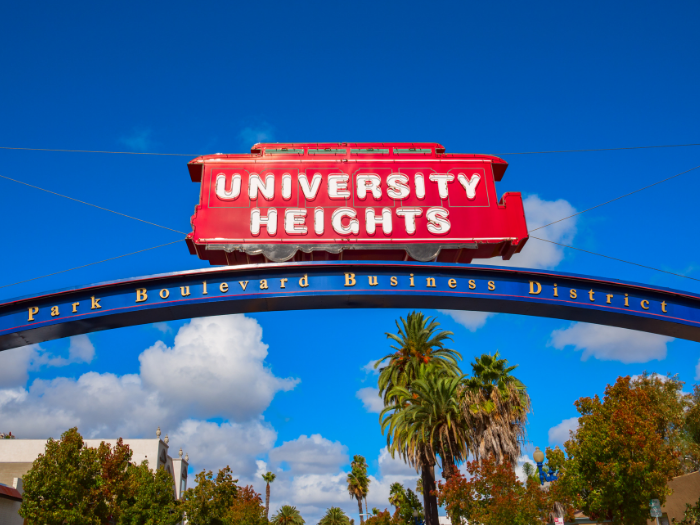
- Home to the original site of San Diego State University and Bentley’s Ostrich Farm
- San Diego State University (SDSU) has its first campus in University Heights in 1898.
- Although some distance from downtown San Diego, University Heights was an early “streetcar suburb,” a residential area whose development was closely tied to direct access to downtown San Diego’s commercial and business center by cable, then electric-powered, trolleys. Just like the more famous San Francisco cable cars, the San Diego Cable Railway traveled south along Fourth Street through University Heights all the way to L Street in downtown San Diego. Here, connections could be made with several steam-powered interurban railroads and the Coronado Ferry. A steam-powered powerhouse and car barn was located at Fourth and Spruce.The cable railway’s tracks entered University Heights at Fourth Street and Fillmore Avenue (today’s corner of Fourth and University in Hillcrest), where it traveled eastward until jogging northeast along University Boulevard (today’s Normal Street) to Carolina Street (today’s Park Boulevard).
- At the end of North Avenue, the northern-most terminus of the cable car line, the San Diego Cable Railway developed a five-acre park with an attractive pavilion designed by prominent local architect William S. Hebbard. The park, known as The Bluffs, was developed by the railway company to attract passengers to the sparsely populated area. However, due to a series of financial setbacks, the cable railway was forced to shut down after just thirteen months of operation. It fell into receivership until 1895, when it was bought by George B. Kerper. Kerper reorganized the company into the Citizens Traction Company, and electrified the line. Kerper restored The Bluffs and renamed it Mission Cliff Park. With a merry-go-round, a playground, and a shooting gallery, the park became the place to go on Sunday afternoons. Dancing parties were held in the pavilion, where Japanese lanterns hung from the rafters. The first outdoor San Diego production of William Shakespeare’s As You Like It was performed at the park in 1897. Theatrical and vaudeville companies also performed here. And, despite much opposition from the San Diego City Council, a liquor license was granted and a German Beer Garden was opened.
- Also in 1904, John D. Spreckels invited Harvey Bentley to relocate his ostrich farm from Coronado.For an additional fee, visitors to the gardens could gaze upon a dozen or more ostriches around the farm. Fearless visitors could even ride the huge birds. Ostrich feathers were in great demand at the time for ladies hats, boas, and stoles and sold for $350 a pound.
- Across the street from the Ostrich Farm was William Hilton’s San Diego Silk Mill (l735 Adams Avenue). Silk production was a thriving industry by the turn of the century. The Chamber of Commerce helped to establish a unique cottage industry in San Diego. Housewives would raise silk worms in their back yards, similar to the Chinchilla craze of the late 1960s.
- In 1913 the Adams Avenue Trolley Barn was built near Mission Cliff Gardens. The popular botanical destination north of downtown was created by John D. Spreckels, who also owned the San Diego Electric Railway Company. The trolley barn was built directly adjacent to Harvey Bentley’s Ostrich Farm, where visitors could actually ride the exotic birds.
- The large brick trolley barn serviced hundreds of cars until 1949. That’s when the streetcars, overtaken by city buses, finally ceased operation.
https://en.wikipedia.org/wiki/University_Heights,_San_Diego
- The name “University” (both for the neighborhood and nearby University Avenue) derives from a plan, originally proposed during the land boom of the 1880s, to build a branch of the University of Southern California in the area.
- University Heights has adopted the ostrich as a unique and memorable symbol. Back in 1903 this neighborhood was the home of Harvey Bentley’s ostrich farm, where visitors could ride the large birds!